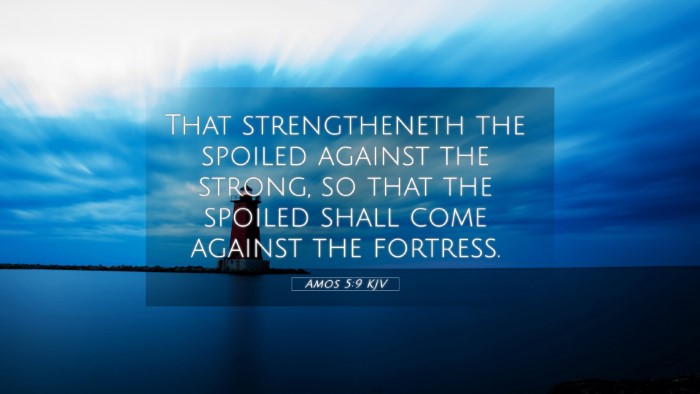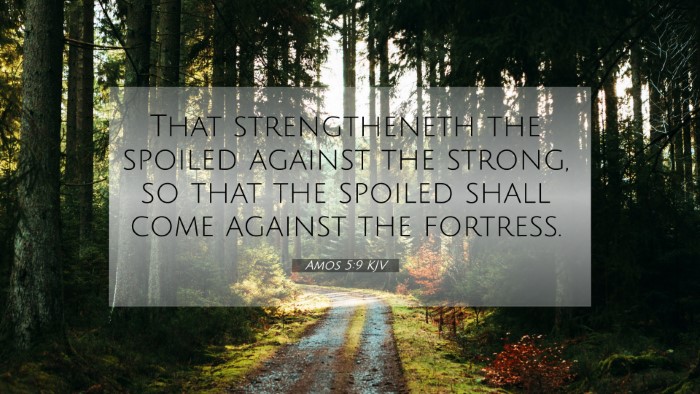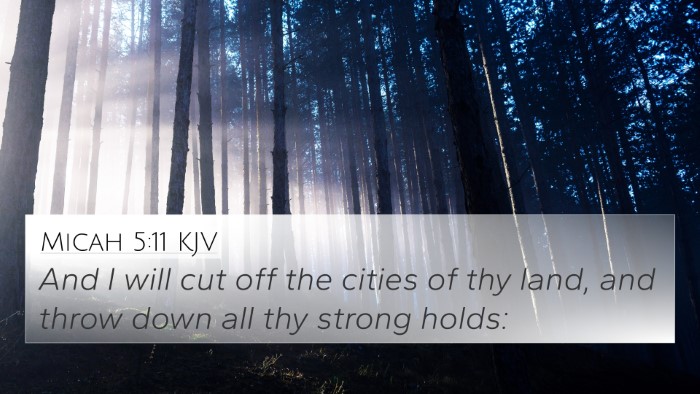Old Testament
Genesis Exodus Leviticus Numbers Deuteronomy Joshua Judges Ruth 1 Samuel 2 Samuel 1 Kings 2 Kings 1 Chronicles 2 Chronicles Ezra Nehemiah Esther Job Psalms Proverbs Ecclesiastes Song of Solomon Isaiah Jeremiah Lamentations Ezekiel Daniel Hosea Joel Amos Obadiah Jonah Micah Nahum Habakkuk Zephaniah Haggai Zechariah MalachiAmos 5:9 Similar Verses
Amos 5:9 Cross References
That strengtheneth the spoiled against the strong, so that the spoiled shall come against the fortress.
Uncover the Rich Themes and Topics of This Bible Verse
Listed below are the Bible themes associated with Amos 5:9. We invite you to explore each theme to gain deeper insights into the Scriptures.
Amos 5:9 Cross Reference Verses
This section features a detailed cross-reference designed to enrich your understanding of the Scriptures. Below, you will find carefully selected verses that echo the themes and teachings related to Amos 5:9 KJV. Click on any image to explore detailed analyses of related Bible verses and uncover deeper theological insights.
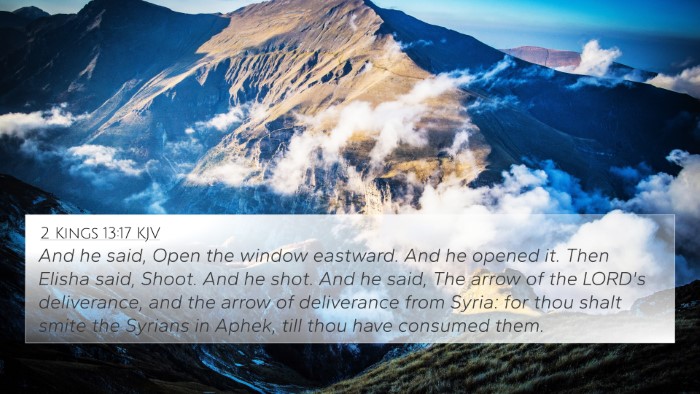
2 Kings 13:17 (KJV) »
And he said, Open the window eastward. And he opened it. Then Elisha said, Shoot. And he shot. And he said, The arrow of the LORD's deliverance, and the arrow of deliverance from Syria: for thou shalt smite the Syrians in Aphek, till thou have consumed them.

2 Kings 13:25 (KJV) »
And Jehoash the son of Jehoahaz took again out of the hand of Benhadad the son of Hazael the cities, which he had taken out of the hand of Jehoahaz his father by war. Three times did Joash beat him, and recovered the cities of Israel.
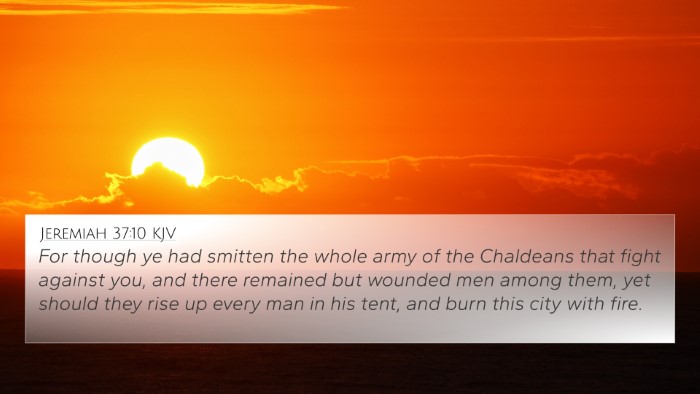
Jeremiah 37:10 (KJV) »
For though ye had smitten the whole army of the Chaldeans that fight against you, and there remained but wounded men among them, yet should they rise up every man in his tent, and burn this city with fire.
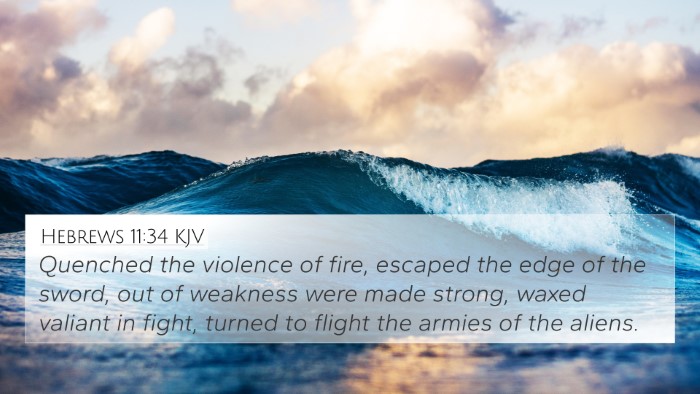
Hebrews 11:34 (KJV) »
Quenched the violence of fire, escaped the edge of the sword, out of weakness were made strong, waxed valiant in fight, turned to flight the armies of the aliens.
Amos 5:9 Verse Analysis and Similar Verses
Understanding Amos 5:9
Amos 5:9 states, "It is He who flashes destruction upon the strong, so that destruction comes upon the fortress." This verse conveys deep theological implications regarding God's sovereignty and the certainty of divine judgment against injustice and corruption. Below, we explore various insights and interpretations from reputable public domain commentaries to enhance understanding.
Contextual Background
The Book of Amos was written during a time when Israel was experiencing prosperity and peace, yet moral decay and social injustice were rampant. Amos, a shepherd and farmer, was called by God to deliver messages of warning and impending judgment. This specific chapter underscores the seriousness of turning away from God’s statutes and the dire consequences that follow.
Verse Meaning and Interpretation
This verse emphasizes God's power and authority to bring about destruction, even upon the most fortified strongholds. Below, we summarize key insights from several commentaries:
- Matthew Henry's Commentary: Henry highlights that God's judgment extends to the mighty and the fortified cities. He illustrates that no human strength can withstand divine wrath when righteousness is forsaken. The "flashing destruction" signifies God's sudden judgment, reinforcing that despite seeming invincibility, all are vulnerable without repentance.
- Albert Barnes' Notes: Barnes focuses on the metaphor of "flashing destruction," suggesting it implies God's swift and overwhelming intervention against injustices. He draws attention to the certainty of God's retribution and the importance of aligning with divine will to escape judgment.
- Adam Clarke's Commentary: Clarke delves into the poetic nature of the language, interpreting "the strong" as those who think themselves secure. He underscores that God’s justice can dismantle the strongholds built on iniquity and pride, serving as a reminder of human frailty before divine authority.
Bible Cross-References
Amos 5:9 is interconnected with several other biblical texts that further illuminate its themes:
- Isaiah 10:34: This verse discusses God's judgment upon the forest of Lebanon, symbolizing His power to bring down the proud and mighty.
- Micah 1:3-4: It describes the coming of the Lord and His judgment, echoing the theme of God's decisive action against those in rebellion.
- Psalm 37:14-15: Here, we see the wicked plotting against the righteous, only to be met with God's assured judgment, paralleling Amos' message on divine retribution.
- Jeremiah 50:29: This passage alerts to the impending vengeance upon those who have oppressed God's people, demonstrating God's commitment to justice.
- Ezekiel 13:14: It speaks of God's judgment upon false prophets, reaffirming the theme of destruction against those who lead His people astray.
- 2 Thessalonians 1:6: This New Testament reference complements Amos 5:9 by indicating that God repays with affliction those who afflict His people.
- Matthew 3:10: John the Baptist warns that the axe is laid at the root of the trees; every tree that does not bear good fruit is cut down, mirroring God's impending judgment in Amos.
Thematic Connections
When studying Amos 5:9, one recognizes significant thematic connections throughout Scripture:
- Divine Judgment: The overarching theme of God’s judgment for sin and injustice is prevalent from the Old Testament prophets to the New Testament writings.
- Human Resilience and Vulnerability: The fortifications of men are juxtaposed against God’s omnipotence, suggesting a recurrent biblical narrative that highlights human limitations in contrast to divine strength.
- Call to Righteousness: God’s desire for repentance and justice permeates biblical texts, exemplified through the prophetic messages across different eras.
Cross-Referencing Biblical Texts
To fully appreciate the implications of Amos 5:9, utilizing tools for cross-referencing can deepen the study:
- Bible Concordance: A comprehensive Bible concordance serves as an essential tool to locate similar themes and connect verses across Scripture.
- Cross-reference Bible Study Guides: These guides can assist in exploring connections and thematic elements between various scriptures.
- Inter-Biblical Dialogue: Engaging in comparative analysis allows for a richer understanding of biblical texts as interconnected narratives.
Conclusion
Amos 5:9 serves not only as a warning about God's impending judgment but also highlights the importance of examining the broader biblical context. By utilizing thematic connections and cross-referencing, one can grasp the profound nature of God’s dealings with humanity. Understanding these parallels enhances one's ability to recognize the continuing dialogue of Scripture from the prophets to the teachings of Jesus and beyond.

